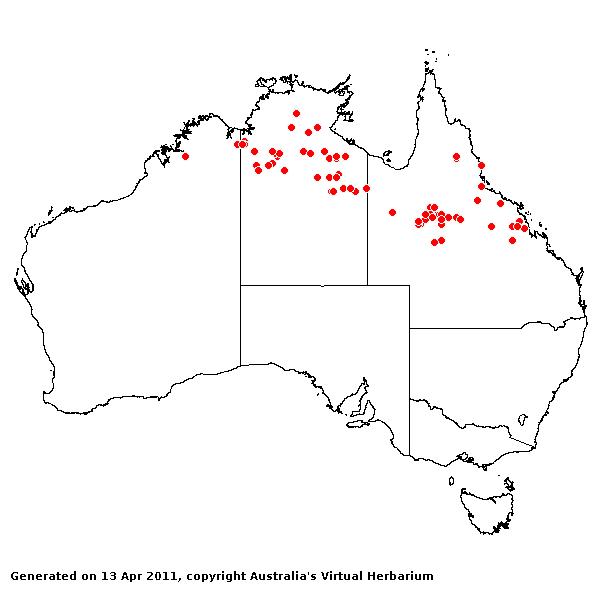Chionachne hubbardiana Henrard. Blumea
3: 162 (1938).
Classification. (GPWG 2001) : Subfamily
Panicoideae. Andropogoneae.
Type of Basionym or
Protologue Information: HT: F. von Mueller s.n., Australia:
Queensland: Sturt's Creek (K; IT: L (fragm.), MELB).
Key references
(books and floras): [1878] G.Bentham, Flora Australiensis 7 (515 as Chionachne
barbata), [1952] C.A.Gardner, Flora of Western Australia 1 Gramineae
(357), [2002] D.Sharp & B.K.Simon, AusGrass, Grasses of Australia.
Habit. Annual.
Culms erect, stature robust to moderate, 30–100 cm tall. Mid-culm internodes
hispid. Mid-culm nodes bearded. Lateral branches branched. Leaf-sheaths hairy.
Ligule a fringed membrane, a ciliolate membrane, 20 mm long, membranous,
ciliate from base of abaxial surface, lacerate. Leaf-blades 6–40 cm long, 5–15
mm wide.
Inflorescence.
Inflorescence compound, composed of rames. Rhachis fragile at the nodes.
Spikelets.
Spikelets sessile, 1 in the cluster. Companion spikelets pedicelled, 1 in the
cluster. Male spikelets sessile and pedicelled, 2 in a cluster. Companion
spikelets rudimentary, 1 mm long. Fertile spikelets 2-flowered, the lower
floret barren (rarely male), the upper fertile, comprising 1 basal sterile
florets, comprising 1 fertile floret(s), without rachilla extension, oblong,
dorsally compressed, 6–11 mm long.
Glumes. Glumes
dissimilar, firmer than fertile lemma. Lower glume ovate, indurate, keeled,
2-keeled, winged on keel, winged broadly. Upper glume ovate, cartilaginous,
keeled, 2-keeled. Florets. Basal sterile florets 1, barren, without
significant palea. Lemma of lower sterile floret hyaline. Fertile florets
female.
Fertile lemma without
keel, 3 -nerved. Anthers 3.
Continental
Distribution: Australasia.
Australian
Distribution: Western Australia, Northern Territory, Queensland.
Western Australia:
Gardner. Northern Territory: Darwin & Gulf, Victoria River, Barkly
Tableland. Queensland: Burke, Cook, Gregory North, Leichhardt, Mitchell,
North Kennedy, South Kennedy.
Notes. Endemic
to tropical Australia. Grows in the wetter areas of black soil plains when it
may become a weed in irrigation channels. Good fodder in -the early stages.
Flowers Nov.--June.



